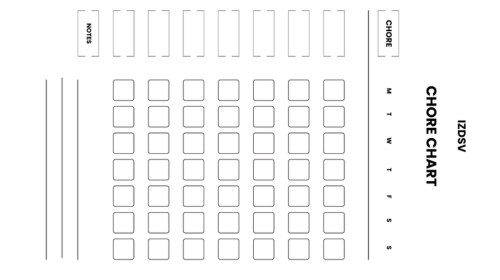Monthly Chore Chart with Allowance Tracking
Why Use a Chore Chart and Allowance System?
A chore chart and allowance system that provides structure and clear expectations for children while teaching them the connection between work and rewards. This approach helps families establish consistent routines and reduces daily negotiations about household responsibilities.
- Creates visual accountability that helps children track their progress and achievements
- Establishes clear expectations for what needs to be done and when
- Reduces parental nagging by making responsibilities visible and self-monitored
- Teaches children that contributing to the household is part of being a family member
- Provides a framework for discussing work ethic and personal responsibility
- Helps children develop time management skills as they learn to complete tasks within deadlines
- Creates opportunities for positive reinforcement when children meet their obligations
The Benefits of Chore Tracking for Kids
Chore tracking helps children develop essential life skills, including organization, time management, and follow-through on commitments. It also builds their confidence as they see tangible evidence of their contributions and accomplishments.
- Develops executive functioning skills like planning, prioritizing, and task completion
- Builds self-confidence through visible achievements and completed responsibilities
- Teaches organizational skills that transfer to schoolwork and other areas of life
- Helps children understand the effort required to maintain a household
- Creates a sense of accomplishment and pride in contributing to family life
- Develops consistency and reliability in completing tasks
- Provides opportunities to learn from mistakes and improve performance over time
- Builds problem-solving skills when children figure out how to complete challenging tasks
How Allowance Encourages Responsibility
Allowance tied to chores teaches children that money must be earned through effort and creates a direct link between work and financial reward. This system helps them understand the value of money and develops their decision-making skills about spending and saving.
- Teaches the fundamental principle that money is earned through work and effort
- Develops budgeting skills as children learn to manage their earnings
- Encourages delayed gratification when children save for larger purchases
- Provides real-world experience with financial decision-making in a safe environment
- Motivates completion of household tasks through tangible rewards
- Teaches the consequences of not fulfilling obligations (no work, no pay)
- Builds understanding of personal finance concepts like earning, spending, and saving
- Creates opportunities for discussions about money management and financial planning
Designing Your Free Chore Chart Template
The design of your chore chart should be visually appealing and age-appropriate to capture your child’s attention and maintain their interest over time. A well-designed template balances functionality with aesthetics, making it easy for children to understand and use independently.
- Include clear sections for the child’s name, week/month dates, and specific chores or tasks
- Use bright, engaging colors that appeal to your child’s preferences and personality
- Incorporate visual elements like checkboxes, stars, or stickers for tracking completion
- Design with adequate space for writing or marking completed tasks
- Consider age-appropriate fonts and sizing that children can easily read
- Include a reward or goal section to maintain motivation and excitement
- Make the layout intuitive so children can navigate it without constant adult assistance
- Add motivational elements like encouraging phrases or fun graphics
Choosing the Right Format: Printable vs. Digital
Printable chore charts offer the tactile satisfaction of physically checking off completed tasks and can be posted in visible locations around the home. Digital formats provide flexibility for easy editing and can include interactive features, though they may require more screen time and technology access.
- Printable charts work well for younger children who enjoy the physical act of marking completion
- Digital formats allow for easy updates and modifications without reprinting
- Printable versions can be laminated for reuse with dry-erase markers
- Digital charts can include automated features like progress tracking and reminders
- Consider your family’s technology comfort level and available devices
- Printable charts don’t require batteries, internet access, or device maintenance
- Digital versions can be shared between divorced parents or caregivers more easily
- Think about where the chart will be displayed and whether physical or digital makes more sense
Editable Chore Chart Ideas for Customization
Editable templates allow you to personalize the chart to match your family’s specific needs, chores, and reward systems. Customization ensures the chart remains relevant and engaging as your child grows and their responsibilities change.
- Add your child’s photo or favorite characters to increase personal connection and engagement
- Include space for both daily and weekly tasks to accommodate different types of responsibilities
- Create categories for different areas like bedroom, bathroom, kitchen, and outdoor chores
- Add difficulty levels or point values for different tasks based on the effort required
- Include sections for extra credit chores that can earn bonus rewards or privileges
- Customize reward options to match your family’s values and your child’s interests
- Add inspirational quotes or family mottos to reinforce positive messages
- Include space for notes or feedback from parents about job quality or improvement areas
Implementing a Chore with Allowance Tracking System
Successfully implementing a chore and allowance tracker requires careful planning and consistent follow-through from all family members. The key is starting with realistic expectations and gradually building the system as children become more comfortable with their responsibilities.
- Begin with a family meeting to explain the new system and get everyone’s input and agreement
- Start small with just a few manageable chores to avoid overwhelming children initially
- Establish clear rules about when chores must be completed and what quality standards are expected
- Create a central location where the tracker is visible and easily accessible to all family members
- Set up regular check-in times to review progress and address any issues or questions
- Prepare backup plans for when children forget or refuse to complete their responsibilities
- Ensure all caregivers understand and consistently enforce the system’s rules and expectations
- Build in flexibility to adjust the system as you learn what works best for your family
Setting Up Chores for Your Children
Age-appropriate chore selection ensures children can successfully complete their tasks while still feeling challenged to grow. The setup process should consider each child’s developmental stage, interests, and the family’s actual household needs.
- Match chores to your child’s age and physical abilities for success and safety
- Include a mix of daily tasks, like making beds, and weekly tasks, like vacuuming
- Consider your child’s schedule, including school, homework, and extracurricular activities
- Assign chores that teach different life skills like cooking, cleaning, organizing, and outdoor maintenance
- Rotate responsibilities periodically to prevent boredom and teach a variety of skills
- Create clear, written instructions for complex tasks to reduce confusion and arguments
- Include both individual tasks and family teamwork opportunities, like meal preparation
- Set realistic timeframes for completion that account for your child’s pace and thoroughness
How to Track Allowance and Rewards
Effective allowance tracking creates transparency and helps children understand the direct connection between their effort and their earnings. A clear system prevents disputes and teaches valuable lessons about earning, saving, and managing money.
- Establish a consistent payday schedule, such as every Sunday evening or the first of each month
- Create a simple ledger or tracking sheet that shows chores completed and money earned
- Decide whether to pay per chore, per week, or use a combination approach
- Include deductions for incomplete or poorly done tasks to teach quality standards
- Set up separate categories for base allowance versus bonus earnings from extra chores
- Provide physical money when possible to make the reward more tangible and meaningful
- Create savings goals and track progress toward larger purchases or financial milestones
- Include family discussions about spending decisions to reinforce money management lessons
Tips for Teaching Kids Financial Literacy
Financial literacy education should start early and be integrated into daily life experiences to make abstract concepts concrete and understandable. The most effective approach combines hands-on practice with age-appropriate explanations that build gradually over time.
- Use real-life shopping experiences to teach concepts like budgeting, comparing prices, and making choices
- Introduce the three-jar system for spending, saving, and giving to teach money allocation basics
- Start with simple math concepts like counting money and making change before advancing to complex topics
- Use visual aids like charts and graphs to help children track their financial progress over time
- Connect financial lessons to their interests, such as calculating how long it takes to save for a desired toy
- Teach the difference between needs and wants through practical examples from daily life
- Introduce basic banking concepts by opening a savings account and visiting the bank together
- Use board games like Monopoly or Payday to make financial learning fun and engaging
Using a Savings Tracker to Encourage Saving
A savings tracker provides visual motivation, helping children see their progress toward financial goals and develop patience for delayed gratification. This tool transforms the abstract concept of saving into a concrete, measurable achievement that children can understand and celebrate.
- Create colorful charts or thermometer-style trackers that show progress toward specific savings goals
- Break large savings goals into smaller milestones to maintain motivation and celebrate small wins
- Include pictures of the item or experience they’re saving for to keep the goal visible and exciting
- Set up matching contributions from parents to teach about interest and investment growth
- Use different colored sections to represent different savings categories, like toys, trips, or charity
- Include dates and amounts to help children understand how regular contributions add up over time
- Celebrate reaching savings milestones with non-monetary rewards like special outings or privileges
- Teach the concept of compound interest using simple examples that they can visualize and understand
Discussing Good Behavior and Financial Responsibility
Regular conversations about the connection between behavior, work ethic, and financial success help children develop strong character alongside money management skills. These discussions should emphasize values like honesty, reliability, and consideration for others as foundations for financial responsibility.
- Connect daily choices to long-term consequences, showing how responsible behavior leads to better opportunities
- Discuss the importance of keeping commitments and following through on responsibilities
- Teach that earning money requires effort, reliability, and quality work, not just showing up
- Emphasize the value of honesty in financial dealings and the importance of earning trust
- Explain how good behavior at home translates to success in school and future employment
- Discuss the responsibility that comes with having money and the importance of wise spending choices
- Teach empathy by discussing how their financial choices affect family resources and others’ needs
- Model good financial behavior and explain your own money decisions to provide real-world examples
Fostering Independence Through Chore Charts
Chore charts serve as powerful tools for developing children’s independence by providing structure, accountability, and clear pathways to personal responsibility. When implemented thoughtfully, these systems create a foundation for lifelong skills that extend far beyond household tasks into academic, professional, and personal success.
- Builds self-reliance as children learn to complete tasks without constant parental supervision or reminders
- Develops time management skills that transfer directly to homework, projects, and future career responsibilities
- Creates a sense of personal ownership and pride in contributing meaningfully to family life
- Teaches problem-solving abilities as children figure out how to complete tasks efficiently and effectively
- Establishes routines that become automatic habits, reducing the mental load of decision-making
- Provides opportunities for children to experience natural consequences in a safe, supportive environment
- Builds confidence through repeated success and the recognition that comes from completing responsibilities
- Develops work ethic and understanding that privileges and rewards come through effort and commitment
- Creates pathways for increased freedom and trust as children demonstrate reliability and maturity
- Establishes communication patterns between parents and children about expectations and accountability
The ultimate goal of any chore chart system is to gradually make itself unnecessary as children internalize the values of responsibility, work ethic, and contribution to their community. When children develop these skills early, they carry them forward into every aspect of their lives, becoming capable, confident, and contributing members of society.




